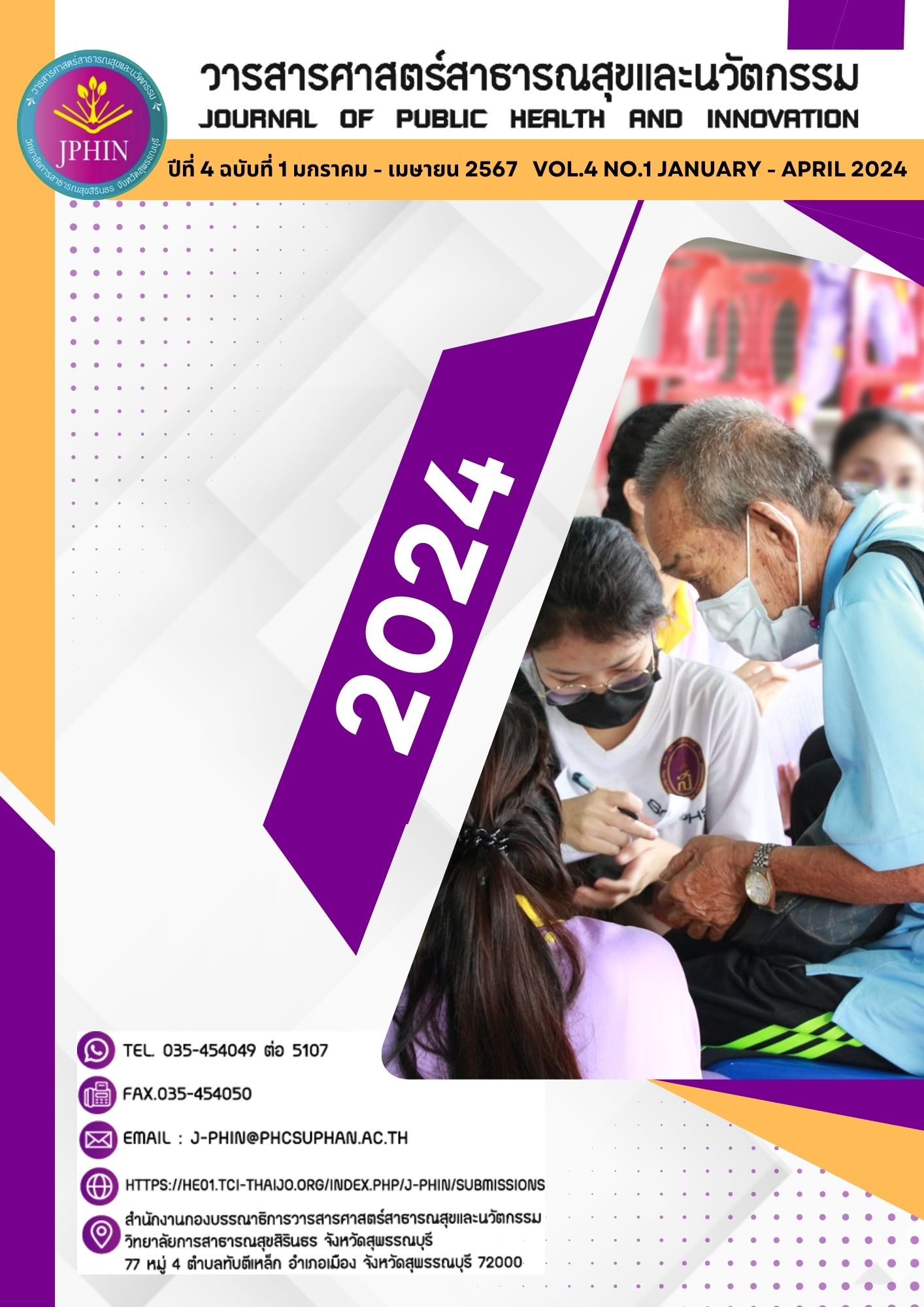Factors Predicting Oral Health Care Behaviors of Parents' Preschool Children in Child Development Centers, Krongpinang District, Yala Province
Keywords:
Oral health care, Preschool children, Parents, Child development centersAbstract
This cross-sectional analytical study aimed to examine oral health care behavior and factors predicting oral health care behaviors of parents’ preschool children in child development centers, Krongpinang district, Yala province. The samples were 225 parents’ preschool children that selected by using multistage sampling. Questionnaires was a tool of data collection in this research that conducted and analyzed by using descriptive statistics and multiple regression analysis.
The results revealed that oral health care behavior was at moderate level (80.00%) and personal factors, predisposing factors, enabling factors and reinforcing factors could jointly predicted oral health care behaviors of parents’ preschool children 56.90% (R²= .569 p < .001). Knowledge of taking care of children's oral health, attitude towards children's oral health care, perceived barrier to prevent oral health problems in children, perceived self-efficacy in caring for children's oral health, access oral care services, received support from family friends or community were factors that could significantly predict oral health care behaviors of parents’ preschool children which had prediction coefficients of -0.116, 0.151, 0.106, 0.184, 0.261, 0.278, (p< .05) respectively
These research outcome could suggest that the relevant agencies should be providing proactive services, developing appropriate models for oral health promotion activities, providing the learning process to promote parents’ perceived self-efficacy for oral health care and preventive oral health problem to reduce perceived barriers of preventing oral health problems in children parents' involvement in behavior modification plan for their children.
References
กรมอนามัย กระทรวงสาธารณสุข. (2561). เด็กไทยกับโรคฟันผุ ปัญหาใหญ่ที่ส่งผลถึงอนาคต. http://multimedia.anamai.moph.go.th/help-knowledgs/kid-and-decay-tooth/
ณัฐธิดา พันพะสุก, อัชชาวดี สักกุนัน, อรวรรณ นามมนตรี, และรัชนีกร สาวิสิทธิ์. (2561). การรับรู้และพฤติกรรมการดูแลสุขภาพช่องปากของผู้ปกครองกับสภาวะสุขภาพช่องปากเด็ก 3-5 ปีในอำเภอซำสูง จังหวัดขอนแก่น. วารสารทันตาภิบาล, 29(2), 13-26.
ที่ว่าการอำเภอกรงปินัง จังหวัดยะลา. (2566). ศูนย์พัฒนาเด็กเล็ก อำเภอกรงปินัง จังหวัดยะลา. https://drive.google.com/file/d/1fXN8_RoUgxi1fqcA0Rqe4IvEkciCA-v5/view?usp=drive_link
ปาริฉัตร ถาวรวงษ์. (2021). พฤติกรรมการดูแลช่องปากของผู้ปกครองเด็กก่อนวัยเรียน ในศูนย์พัฒนาเด็กเล็ก อำเภอพระพรหม จังหวัดนครศรีธรรมราช. วารสารศาสตร์สุขภาพและการศึกษา, 1(2), 69-82.
โรงพยาบาลกรงปินัง. (2565). ผลการตรวจฟันเด็กในศูนย์พัฒนาเด็กเล็กในเขตอำเภอกรงปินัง.
วิจิตรา รทะจักร, ลภัสรดา หนุ่มคำ และสุรางค์ รัตน์พ้องพาน. (2563). ปัจจัยทำนายพฤติกรรมการดูแลสุขภาพช่องปาก เด็กอายุ 1 ปีครึ่ง ถึง 3 ปี ของผู้ปกครอง อำเภอเวียงสา จังหวัดน่าน. วารสารวิทยาศาสตร์และเทคโนโลยี, 1473-1489.
สมพร แก้วทอง, เปมิกา ฉิมคง, อมลวรรณ แก้วละมุล, ดุษฎี เจริญสุข, และวรรณวิมล เมฆวิมล
กิ่งแก้ว. (2565). ปัจจัยที่มีความสัมพันธ์ต่อพฤติกรรมการดูแลสุขภาพช่องปากของเด็กก่อนวัยเรียน ของผู้ปกครองในศูนย์พัฒนาเด็กเล็ก อำเภอวารินชำราบ จังหวัดอุบลราชธานี. วารสารสหเวชศาสตร์ มหาวิทยาลัยราชภัฏสวนสุนันทา, 7(2), 56-70.
สำนักทันตสาธารณสุข กรมอนามัย. (2561). รายงานผลการสำรวจสภาวะสุขภาพช่องปากแห่งชาติ ครั้งที่ 8 ประเทศไทย พ.ศ. 2560. https://dental.anamai.moph.go.th/web-upload/migrated/files/dental2/n2423_3e9aed89eb9e4e3978640d0a60b44be6_survey8th_2nd.pdf
สำนักงานสาธารณสุขจังหวัดยะลา. (2566). ร้อยละเด็กกลุ่มอายุ 3 ปีมีฟันผุในฟันน้ำนม.https://yla.hdc.moph.go.th/hdc/reports/report.php?cat_id=db30e434e30565c12fbac44958e338d5&id=e9f3192f523c79cbbbcf7b405e879384
องค์การยูนิเซฟ ประเทศไทย. (2566). การพัฒนาเด็กปฐมวัย "ก้าวแรกแห่งชีวิตที่ดีเพื่อเด็กทุกคน". https://n9.cl/n7ibr
Best, J. W. (1977). Research in education. Prentice-Hall.
Bloom, B. S., et al. (1971). Hand book on Formative and Summative Evaluation of Student Learning. Mc Graw-Hill Book Company.
Green, L. W., & Kreuter, M. W. (2005). Health program planning: an educational and ecological approach. McGraw-Hill.
Pander, N. J. (1996). Health promotion in nursing practice. Appleton and lange.
Stretcher, V.J., & Rosenstock, I. M. (1997). The Health Belief Model. San Francisco: Jossey-Bass.
Weiers, R. M. (2005). Introduction to Business Statistics. International StudentEdition. Pennsylvania, USA: Duxbury Press,Thomson - Brooks/cole.
World Health Organization. (2022). Global oral health status report. https://www.who.int/team/noncommunicable-diseases/global-status-report-on-oral-health-2022
Downloads
Published
How to Cite
Issue
Section
License
Copyright (c) 2024 Sirindhorn College of Public Health, Suphanburi

This work is licensed under a Creative Commons Attribution-NonCommercial-NoDerivatives 4.0 International License.
1. บทความหรือข้อคิดเห็นใด ๆ ที่ปรากฏในวารสารศาสตร์สาธารณสุขและนวัตกรรม ที่เป็นวรรณกรรมของผู้เขียน บรรณาธิการ ไม่จำเป็นต้องเห็นด้วย
2. บทความที่ได้รับการตีพิมพ์ถือเป็นลิขสิทธิ์ของ วารสารศาสตร์สาธารณสุขและนวัตกรรม






